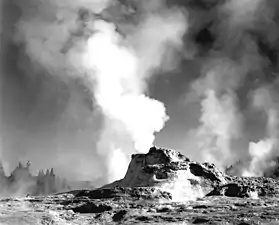
Aldo Starker Leopold (October 22, 1913 – August 23, 1983) was an American author, forester, zoologist and conservationist. He also served as professor at the University of California, Berkeley for thirty years. Throughout his life, Leopold was active in numerous wildlife and conservation groups throughout the United States. Leopold later defended his ideas of Land ethic which was a new way to connect nature, land and people.[1]
Family and education
Born in Burlington, Iowa, in 1913, A. Starker Leopold was the oldest son of noted conservationist Aldo Leopold and Estella Bergere Leopold. His siblings—Luna, Carl, Estella, and Nina—all made contributions to the conservation movement. As a result of his father's employment by the United States Forest Service, Starker Leopold spent some of his youth in New Mexico; when his father began teaching at the University of Wisconsin, the family moved to Madison.[2]
He received his B.S. from the University of Wisconsin in 1936, and then studied at the Yale Forestry School before transferring to the University of California, Berkeley, where he received his Ph.D. in Zoology in 1944. He had a specific interest in avian wildness.[3] In 1938 he married Elizabeth Weiskotten; the couple had two children.[2]
Career at Berkeley
After working in Mexico for the Conservation Section of the Pan-American Union, Leopold returned to Berkeley in 1946 as Assistant Professor of Zoology and Conservation in the Museum of Vertebrate Zoology. He became professor in 1957. For three years (from 1960–1963) he was Assistant to the Berkeley Chancellor. In early 1967, he changed his affiliation to the School of Forestry and Conservation, where he was professor of Zoology and Forestry until his retirement as Professor Emeritus in 1978.[4] He also served as Director of the Sagehen Creek Field Station from 1965 to 1978.
Conservation and authorship
In 1962, A. Starker Leopold was appointed as chairman to the Special Advisory Board on Wildlife Management by Secretary of the Interior Stewart Udall. Leopold retained this association until his death twenty years later.[5] The Advisory Board was responsible for writing what is known as the Leopold Report, a series of recommendations regarding wildlife and ecosystem management in the country's national parks. More specifically a reoccurring issue in Yellowstone National Park was the mass killing of the elk population and in order to prevent over population workers hunted them. In this report he invalidated the idea of controlling a population regarding it as unethical. Instead Leopold fought for land health and the upkeep of plant and animal populations rather than the control over them.[6] The Report is recognized as a seminal work for the conservation movement.
Leopold was also an active member of numerous conservation committees and organizations, including The Nature Conservancy, Sierra Club, The Wildlife Society (of which his father was a founding member), and the National Wildlife Federation.[4] He was also elected to the National Academy of Sciences in 1970.
In addition to the more than 100 scientific papers he authored, Leopold wrote five books during his life, he was working on a sixth at the time of his death.[5] While his writings were not at the forefront in the scientific community, his later works started to focus less on research and more on developing public policy. Leopold took ideas in the scientific community and launched them into political arena, forming many policies that still stand today.[7]

Books
- Wildlife in Alaska (with F. F. Darling) (1953)
- Wildlife of Mexico: The Game Birds and Mammals (1959)
- The Desert (1961; Revised 1962; Series: LIFE Nature Library)
- The California Quail (1977)
- North American Game Birds and Mammals (1982) (with R. Guttierez and M. Bronson)
- Wild California: Vanishing Lands, Vanishing Wildlife, (posthumous, with Elizabeth Leopold), photographs by Tupper Ansel Blake. University of California Press/The Nature Conservancy, 1985
References
- ↑ Jürgens, Uta Maria (2014-09-30). "Compassionate Coexistence". Journal of Ethics and Emerging Technologies. 24 (3): 60–64. doi:10.55613/jeet.v24i3.33. ISSN 2767-6951.
- 1 2 Sterling, Keir Brooks. Biographical Dictionary of American and Canadian Naturalists and Environmentalists. Greenwood Publishing Group, 1997. ISBN 0-313-23047-1, p. 457.
- ↑ Harmond, Richard (February 2000). Leopold, A. Starker (1913-1983), wildlife biologist, conservationist, and educator. American National Biography Online. Oxford University Press. doi:10.1093/anb/9780198606697.article.1302318.
- 1 2 Raitt, RJ (1984). "In Memoriam: A. Starker Leopold" (PDF). Auk. 101 (4): 868–871. doi:10.2307/4086914. JSTOR 4086914.
- 1 2 "National Park Service: Biography (A. Starker Leopold)". The National Park Service. Retrieved June 17, 2009.
- ↑ Hügler, Stephanie (September 2009). "Häusliche Quarantäne: Brötchenkaufen ist erlaubt". Deutsche Medizinische Wochenschrift. 134 (37): 32. doi:10.1055/s-0028-1124085. ISSN 0012-0472.
- ↑ Rydell, Kiki Leigh (1998). "A Public Face for Science: A. Starker Leopold and the Leopold Report". The George Wright Forum. 15 (4): 50–63. ISSN 0732-4715.
- ↑ copy of the physical book, which not only gives copyright dates 1985, but is signed and dated by Blake